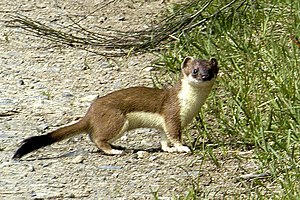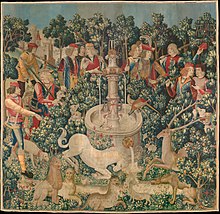ermine
| ermine | ||||||||||||
|---|---|---|---|---|---|---|---|---|---|---|---|---|

Ermine in summer fur |
||||||||||||
| Systematics | ||||||||||||
|
||||||||||||
| Scientific name | ||||||||||||
| Mustela erminea | ||||||||||||
| Linnaeus , 1758 |
The ermine ( Mustela erminea ), also called the great weasel or short-tailed weasel , is a species of predator from the marten family (Mustelidae). It is best known for its white fur in winter and for a time played an important role in the fur industry . The ermine is classified within the genus Mustela in the subgenus Mustela and is thus closely related to the mouse and long-tailed weasel, among others .
features

Ermines have the elongated, slender body typical of many martens, with rather short legs and a short tail. In their summer fur they show the typical coloration of many weasels with a brown top and white underside. In winter fur it is completely white, with the exception of a black tail tip, which makes it clearly distinguishable from the mouse weasel . However, this change of coat does not take place in all parts of the distribution area. In the warmer areas, ermines are brown-white all year round, but in the far north they never lose their white winter fur. The animals reach a head-trunk length of 17 to 33 centimeters, the tail is four to twelve centimeters long and their weight is 40 to 360 grams. Males are slightly larger and heavier than females. After the weasel , the ermine is the second smallest domestic predator .
distribution and habitat
The ermine is common in the temperate and subarctic zones of the northern hemisphere . It inhabits Europe from the Pyrenees , Alps, and Carpathians north, northern and central Asia (including Japan ), parts of Greenland , Canada, and the northern edge of the United States . The ermine was introduced in New Zealand . In Australia there is a warning about the risk of introduction and establishment, which has not yet taken place.
Ermines inhabit a number of landscape types, with habitats near water appearing to be preferred. A biotope connection is not recognizable, instead there is a close connection to the occurrence of shearers, earth mice and field mice. Structurally rich landscapes are typical. B. with meadows, hedges and field trees or residential gardens. Closed forests, however, are avoided. Ermines can be found at heights of up to 3400 meters.
Way of life
Ermines are mainly active during the day and at dusk, in winter they are mainly active at dusk or at night. Longer periods of rest (3–5 hours) often alternate with activity phases of just under an hour. They prefer crevices, hollow tree trunks, piles of wood and stone or abandoned burrows of other animals as cover and shelter. Often they have several nests in their territory, which they line with dry vegetation, hair or feathers.
Outside the mating and rearing season, they live solitary in large action areas (max. 200 hectares), which are significantly smaller in winter (min. 2 hectares). In summer, males often roam areas of around 20 ha every day, the females then use around 8 ha. Both sexes mark the territorial boundaries with anal gland secretions . Same-sex intruders usually withdraw when they meet, otherwise they are vehemently driven away.
Food and hunting
Mostly, ermines hunt small mammals like mice , rats , rabbits , shrews and moles . Especially when there is a shortage of small mammals, they also consume smaller birds and, rarely, reptiles , fish and insects . Significant prey all year round are i. d. R. voles of the genera Arvicola and Microtus such as water voles and field mice .
The ermine prefers to look for food during the day and during the twilight, it orientates itself mainly by smell and hearing, it often makes it "male". Once the prey has been recognized, it sneaks up to kill it quickly and surprisingly with a bite in the neck and then carry it into the burrow. It is reported that ermines confuse rabbits by acting so much that they do not flee.
The earlier common assumption that ermines suck the blood out of their prey is wrong.
Reproduction and Life Expectancy
The mating takes place in late spring or summer, after which it comes to dormancy , that is, the fertilized egg does not implant until March of the following year. The actual gestation period is therefore only about a month, and 3 to 18 (average 6 to 9) young are born in April or May. They only weigh around two to three grams and are blind and helpless; they are only cared for and defended by the female. They are suckled for six weeks; During this time, they look like the adults. Females (Fähen) can reproduce in their first year of life; Males, however, only reach sexual maturity at one year of age.
The infancy is remarkable - females can be mated as early as infancy. Often this is done by the biological father himself. The behavior or ability should ensure that all the females are mated even in years with few stocks.
The average life expectancy of an ermine is only one to two years. This is ensured by many predators, including birds of prey, owls , foxes and badgers . In theory, however, they can reach an age of seven years.
Many stoats also suffer from a parasitic nematode ( Skrjabingylus nasicola ), which is transmitted from shrews and lives in the nasal cavity; it later invades the brain and causes the death of its host.
Ermine and people

Farm animal
Ermines feed mainly on small rodents ; they were popular as mouse catchers on many farms before the domestic cat spread over large areas . They have been kept as pets not just since today . Ermines are rarely bred for fur purposes, they are mostly hunted (e.g. in Eastern Europe , but also in Germany). For fur usage see ermine fur .
symbolism
A legend, according to which an ermine would rather die than dirty its white winter fur in the mud, forms the background for the motto "malo mori quem foedari" ("rather die than be defiled") of the Neapolitan order of ermines . Where and when the legend originated is unknown, but in large parts of medieval Europe the white ermine fur was a symbol of - moral - purity ( chastity ) and innocence.
The white winter fur of the ermine was - also and precisely because of the inherent symbolism - considered to be particularly valuable. An ermine coat was at times the privilege of noble families. The ermine is to this day as heraldic tincture or in natural representation a component of the coats of arms of formerly noble residences and areas. Emperors, kings and princes as well as the Pope wore clothes lined or covered with white winter fur, on which the black tails or tail tips were sewn as a special characteristic.
Due to the fact that only high secular and ecclesiastical dignitaries were allowed to wear a precious ermine coat, such a coat became an insignia of power as early as the end of the Middle Ages, especially in the time of absolutism ( Louis XIV. ).

The weasel, especially the ermine, has been considered an animal since ancient times that, after consuming rue , an antidote also in Christological symbolism, receives special powers against snakes (and basilisks ) and their poison.
Order of knights
In religious orders , two secular orders of knights have been named after the animal:
- the Order of Ermine , founded by the Breton Duke Johann V in 1381 , which came under the control of the French king in the 16th century - in connection with the incorporation of Brittany into the French crown - and sank into insignificance.
- the Neapolitan Order of Ermine , donated by King Ferdinand I in 1464 .
coat of arms
The ermine was also used as a tincture in coats of arms - first probably in 1213 in the coat of arms of the then still independent Duchy of Brittany , where it has survived to this day (in a modified form and as a symbol of independence); The Breton department coats of arms also show ermine tinctures. The coat of arms of the Limousin region is also adorned with the heraldic ermine against the background of dynastic relations with Brittany ( Guy de Penthièvre ) .
Heraldic coats and hats are important heraldic heraldic elements and are decorated with realistic or stylized fur of the animal.
literature
- Ronald M. Nowak: Walker's Mammals of the World . 6th edition. Johns Hopkins University Press, Baltimore 1999, ISBN 0-8018-5789-9 (English).
Web links
- Mustela erminea in the endangered Red List species the IUCN 2008. Posted by: F. Reid, K. slipway, 2008. Accessed on January 1 of 2009.
- Category “ermine clothing” on Wikipedia Commons
- Ermine - hunting etc. NABU Germany
- Hermelin Natural Lexicon (further information and photos)
Individual evidence
- ^ Risk Assessment for Australia - Stoat (Mustela erminea) (Linnaeus, 1758) . Department of Agriculture and Food, July 2008. Retrieved May 2, 2020.
- ↑ a b c Rainer Allgöwer: Hermelin (Great Weasel) Mustela erminea Linnaeus, 1758 . In: Monika Braun (Ed.): Die Säugetiere Baden-Württemberg, Vol. 2 . Ulmer Verlag, Stuttgart 2005, pp. 451–458. ISBN 3-8001-4246-5 .
- ↑ http://m.tierwelt.ch/?rub=4495&id=36232 Matthias Gräub: The Hermelin is a hypnosis artist , report from Tierwelt-Verlag / Switzerland, accessed on March 13, 2018
- ↑ http://biologisches-institut-oldenburg.de/wp-content/uploads/2011/08/hermelin.pdf Jens Kleinekuhle: Our domestic predatory mammals Part 3: Marten-like, the large weasel or ermine , Biological Institute Oldenburg, accessed on 13 March 2018
- ↑ So with Pliny , confirmed by Leonardo da Vinci and in the emblem book Symbolorum et emblematum ex animalibus quadrupedibus desumtorum centuria altera collecta (Nuremberg 1595) by Camerarius .
- ↑ Christina Becela-Deller: Ruta graveolens L. A medicinal plant in terms of art and cultural history. (Mathematical and natural scientific dissertation Würzburg 1994) Königshausen & Neumann, Würzburg 1998 (= Würzburg medical-historical research. Volume 65). ISBN 3-8260-1667-X , pp. 199, 208 f. and 211.




